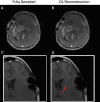A critical assessment of artificial intelligence in magnetic resonance imaging of cancer
- PMID: 40226507
- PMCID: PMC11981920
- DOI: 10.1038/s44303-025-00076-0
A critical assessment of artificial intelligence in magnetic resonance imaging of cancer
Abstract
Given the enormous output and pace of development of artificial intelligence (AI) methods in medical imaging, it can be challenging to identify the true success stories to determine the state-of-the-art of the field. This report seeks to provide the magnetic resonance imaging (MRI) community with an initial guide into the major areas in which the methods of AI are contributing to MRI in oncology. After a general introduction to artificial intelligence, we proceed to discuss the successes and current limitations of AI in MRI when used for image acquisition, reconstruction, registration, and segmentation, as well as its utility for assisting in diagnostic and prognostic settings. Within each section, we attempt to present a balanced summary by first presenting common techniques, state of readiness, current clinical needs, and barriers to practical deployment in the clinical setting. We conclude by presenting areas in which new advances must be realized to address questions regarding generalizability, quality assurance and control, and uncertainty quantification when applying MRI to cancer to maintain patient safety and practical utility.
Keywords: Biomedical engineering; Cancer imaging; Image processing.
© The Author(s) 2025.
Conflict of interest statement
Competing interestsCaroline Chung – Research funding to the institution from Siemens Healthineers and RaySearch Laboratories
Figures




Similar articles
-
ATOMMIC: An Advanced Toolbox for Multitask Medical Imaging Consistency to facilitate Artificial Intelligence applications from acquisition to analysis in Magnetic Resonance Imaging.Comput Methods Programs Biomed. 2024 Nov;256:108377. doi: 10.1016/j.cmpb.2024.108377. Epub 2024 Aug 22. Comput Methods Programs Biomed. 2024. PMID: 39180913
-
The Applications of Artificial Intelligence in Cardiovascular Magnetic Resonance-A Comprehensive Review.J Clin Med. 2022 May 19;11(10):2866. doi: 10.3390/jcm11102866. J Clin Med. 2022. PMID: 35628992 Free PMC article. Review.
-
Current State of Artificial Intelligence in Clinical Applications for Head and Neck MR Imaging.Magn Reson Med Sci. 2023 Oct 1;22(4):401-414. doi: 10.2463/mrms.rev.2023-0047. Epub 2023 Aug 1. Magn Reson Med Sci. 2023. PMID: 37532584 Free PMC article. Review.
-
Artificial Intelligence in Cardiac MRI: Is Clinical Adoption Forthcoming?Front Cardiovasc Med. 2022 Jan 10;8:818765. doi: 10.3389/fcvm.2021.818765. eCollection 2021. Front Cardiovasc Med. 2022. PMID: 35083303 Free PMC article. Review.
-
[Applications of Artificial Intelligence in MR Image Acquisition and Reconstruction].J Korean Soc Radiol. 2022 Nov;83(6):1229-1239. doi: 10.3348/jksr.2022.0156. Epub 2022 Nov 30. J Korean Soc Radiol. 2022. PMID: 36545429 Free PMC article. Review. Korean.
References
-
- Chen, Y. et al. AI-based reconstruction for Fast MRI—A systematic review and meta-analysis. Proc. IEEE110, 224–245 (2022).
-
- Li, C. et al. Artificial intelligence in multiparametric magnetic resonance imaging: A review. Med. Phys.49, 10.1002/mp.15936 (2022). - PubMed
-
- McCarthy, J., Minsky, M. L., Rochester, N. & Shannon, C. E. A proposal for the Dartmouth Summer Research Project on Artificial Intelligence, August 31, 1955. AI Mag.27, 12 (2006).
Publication types
Grants and funding
LinkOut - more resources
Full Text Sources
